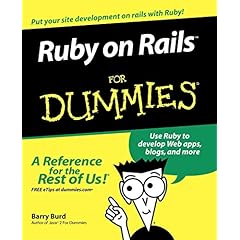Here’s a fascinating market indicator. I was looking for a Ruby book on Amazon, something for lightweight coders, perhaps a beginner’s guide to Ruby on Rails. What did I find? I found a total of 23 books. 9 of them are hitting the shelves within weeks. All of the others were published within the last 6 months.

Here’s a sampling of what’s coming out soon:
- Beginning Ruby on Rails: From Novice to Professional
- Ruby on Rails Power!: The Comprehensive Guide
- Rails Solutions: Ruby on Rails Made Easy
- Ruby on Rails For Dummies
- Beginning Ruby on Rails E-Commerce: From Novice to Professional
The blogosphere saw the Ruby on Rails thing coming a while back. Now the book publishers see it, too, and they’re all racing to get a piece of the action.
There are other interesting indicators like the fact that Dreamhost offers it preinstalled as part of its hosting package. And you can’t ignore the recent adoption of Agile project management which feeds nicely into the Rails approach, even sharing language and concepts at the same level of abstraction.
Yesterday, I asked Jeremy Zawodny how his experiments with Ruby on Rails are going, so far. He replied,
“It’s frighteningly productive.”
I wonder if the venture and acquisition machines out there will learn how to plug into this market architecture. In 1999, startups did the Sand Hill march using PowerPoint as their weapon of choice. The right buzzwords in the right order and charts pointing high and to the right put many on the IPO course before engineers had been hired.
Investors today are looking for working ideas with real customers.
There’s a perfect storm forming.
